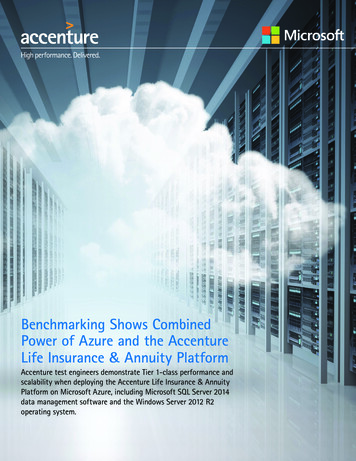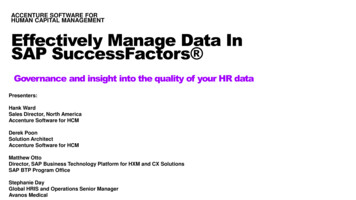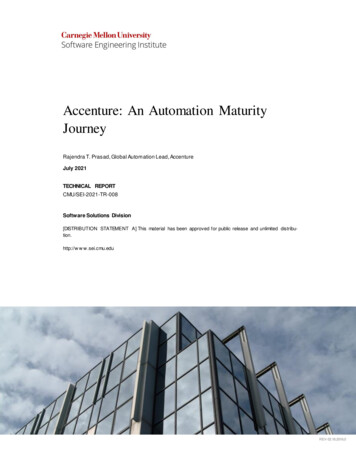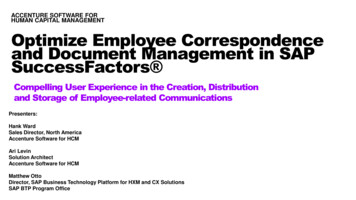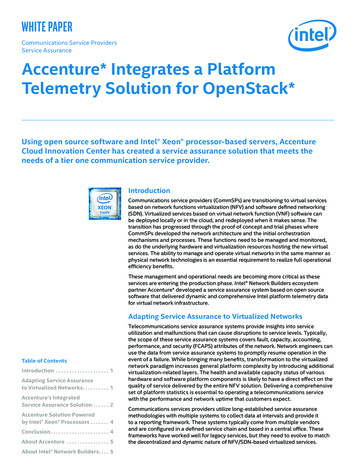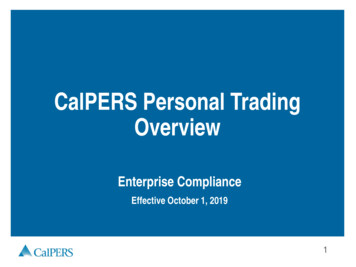
Transcription
Accenture PaymentsVirtual Accountsand Virtual AccountManagementA Major Opportunity for Today’sTransaction Banks
Table of ContentsVirtual Accounts3Introduction3The promise of Virtual Accounts4Client segmentation and analysis5The value proposition of Virtual Accounts for the target client segments6The value proposition for bank6Comparison of global bank offerings8Virtual Account Management10What is Virtual Account Management?10Available market solutions12Bank solution versus ERP solution12Innovation in the marketplace: VAM will become multi-bank12Impacts of Virtual Account Management on banks’ operating models13Solution and solution implementation considerations14Closing Thoughts15Legal disclaimerAccenture is a global provider of professional information technology solutions and services.Accenture refers to one or more of Accenture Inc., its subsidiaries and related entities.This publication contains general information only, Accenture is not rendering professional advice orservices by means of this publication. Views and opinions expressed in this document are based onAccenture’s knowledge and understanding of its area of business, markets and technology. They do notconstitute advice of any nature relevant to your position, circumstances or otherwise and moreoverdo not constitute legal interpretation of the requirements of any applicable law or regulation orany related legal and regulatory material. The publication does not take into account any applicablelegal or regulatory requirements that apply to the matters discussed in this publication. Accenturedoes not provide any legal advice nor does it offer any. Before making any decision or taking anyaction that may affect your finances or your business, you should consult a qualified professionaladviser. Accenture shall not be responsible for any loss whatsoever sustained by any person whorelies on this publication. Any party that relies on the information does so at its own risk.2
Virtual AccountsTransaction or wholesalebanking as we have known itfor decades is changing, dueto the impacts of the digitalrevolution and the everintensifying pressures fromseveral stakeholder groups:Regulators expect banks to be moreprudent in their financial and riskmanagement, and also to relinquish theirstrong hold on account managementservices by opening up their accountmanagement systems to third parties.The pressure on banks to comply withregulators’ requirements is reflected bybanks making this one of the top prioritiesin their strategic agendas.Business customers are demanding theirbanks change in line with the externalrealities, and expect to be offeredcontemporary products that support theirown strategies and growth agendas.Shareholders are anxious aboutprofitability: low interest rates have madeit increasingly difficult for transactionbanks to maintain profitability giventhe large cost burden that comes withtransaction banking. Also, the market hasseen moves recently where banks simplywithdraw from the transaction bankingindustry because they no longer cansustain operations in it profitably.Looking across a transaction bank’sproduct portfolio, customers requirebanks to offer them cash managementproducts that will allow them to optimizetheir working capital and short-termfunding and liquidity needs. Traditionally,these customers have benefited fromconventional cash pooling solutionssuch as notional pooling and cash flowforecasting. Nowadays, buoyed byincreasing costs and the desire to havedeeper insight into – and exercise greatercontrol over – their liquidity positions,these corporate customers are seekingalternative solutions. Their primaryobjectives are to rationalize their financialaccounting structures, further streamlinetheir reconciliation process for bothpayments and collections, and improvetheir liquidity risk management.In light of these demands from customers,banks are exploring new innovationsin the transaction banking space. Onesuch innovation is virtual accounts, aconcept that we examine in this paper.It is important to note that virtualaccounts are not new: products of thistype have been in the market for around20 years, serving specific purposesfor corporate and SME customers. Yetthe changes in market dynamics withrespect to regulation and customerrequirements, coupled with the driveby banks to achieve greater operationalefficiency, have created a widely-heldview that virtual accounts may now bea highly promising market propositionfor today’s transaction banks.3
The promise of Virtual AccountsSo, what are virtualaccounts? Also referred toas ‘shadow accounts’, theyare essentially non-physicalaccounts that can be usedby clients to optimize theirworking capital processes.Looking more closely, froma European perspective, thiscategory actually includestwo different productpropositions being offeredby banks: virtual IBANs andvirtual account solutions.Virtual IBANs are a mechanism toimprove straight through reconciliation ofreceivables for corporate clients. Undersuch an offering, a bank would open aseries of dummy IBANs for its client.Underlying each of these virtual IBANs isa real physical account (held in the bank’sledger) to which the payments made tothese virtual accounts are routed. Withthis arrangement in place, the client thenhas the flexibility to assign these IBANsto its individual suppliers, so that when asupplier makes an electronic payment itwould automatically go into the relevantvirtual IBAN.Once the payment hits the bank’s corebanking system, a virtual accountengine maps the payments made tothese virtual IBANs to the real accountnumber, enabling the funds to be clearedto this physical account. The virtualIBANs are also captured in the accountstatements, allowing clients to identifythe payment originators and therebysimplifying their reconciliation process.This type of product also eliminates theneed to reconcile receivables informationmanually. Given the flexible nature ofthis offering, many clients are open toassigning one virtual IBAN per supplierper geography, using the receivablesinformation from the account statementsto help them achieve improved workingcapital efficiencies.By contrast, virtual account solutions area more comprehensive offering, providingclients with a cost-effective means ofcentralizing their accounts payables andreceivables. With this type of solution,clients gain the flexibility to design andopen complex shadow account hierarchiesfor a real physical account maintained inthe bank’s physical ledger, in line with itsbusiness needs. With virtual accounts,banks retain control of the underlyingbank account while allowing corporateclients to manage the virtual accountsthat are driven off it. Self-servicingcapabilities allow corporates to definetheir virtual accounting structures in linewith their business needs, with flexibilityto do so at a legal entity or a businessunit level and even for more complexconstructs such as joint ventures.With the virtual accounts in place, clientscan then use them to make payments onbehalf of (POBO) and receive collectionson behalf of (COBO) the main physicalaccount. Since these are just shadowaccounts, no physical movement ofWith the actual movement of fundstaking place through a single mainaccount, clients could theoretically runtheir entire operations with just onephysical bank account, thereby enablingthem to transform their approach to cashmanagement and how they make andcollect payments. This type of offeringgenerates benefits including improvedreconciliation and working capitalmanagement at lower cost, since hardlyany labor-intensive account openingor closing administration activities arerequired. Virtual accounts also provideclients with much more self-servicefacilities and control.Figure 1: Schematic of a typical virtual account solutionClient EnvironmentBank EnvironmentVirtual Account Shared environmentCore BankingShadow Main AccountMain AccountBANKABCXXXX123BANKABCXXXA123Subsidiary 1BANKABCXXXA12311BANKABCXXXA12312Payments onbehalf of (POBO)BANKABCXXXA12313Subsidiary 2BANKABCXXXA12321Collections onbehalf of (COBO)4money happens between these accountsand the main account. Virtual accountsof this nature are usually administeredusing market-ready virtual accountmanagement solutions that operate inthe working environments of both thebank and the client. We’ll say more aboutvirtual account management systemslater in this paper. Figure 1 illustrates howvirtual account solutions work.BANKABCXXXA12322POBOActual moneymovementhappens throughthe main accountCOBO
Client segmentation and analysisFor the purposes of this paper,we’ve applied the followingcriteria to identify the targetclient segments who wouldbe most interested in virtualaccounts offerings from banks: On average more than five bankingrelationships More than one million transactionsannually for inbound/outboundpayments Reliant on cash pooling productsfor managing liquidity Usage of complex treasury managementsystems – e.g. ERP systems, treasuryworkstations, or software-as-a-service(SaaS) solutions.As the diagram shows, virtual accountsare great for corporate groups – beingsuitable for a few SMEs but typicallylarge corporates and multinationals. If acorporate group or holding company cancentralize its cash position, the liquidityotherwise trapped locally in complex bankaccount structures can be freed, therebysubstantially improving the availableworking capital.Based on these criteria - three key clientsegments for transaction banks is shownin figure 2. More than 100 accounts held acrossdifferent banks in totalFigure 2: Target client segment most likely to be interested in virtual accounts offerings from banksIdentified criteria for targetclient segmentsSMELarge CorporatesMultinational Corporations 5 Banking relationships100 accountsAnnual payment Volumes(incoming/outgoing) 1MMReliant on cash pooling structuresfor liquidity ManagementUses Complex TreasuryManagement Analysis based on gtnews survey for Transaction Banking, 2014Source: Accenture Research5
The value proposition of Virtual Accountsfor the target client segmentsWhile promising tremendousbenefits, operating a virtualaccount environment willrequire significant time andeffort both from banks aswell as their customers. Forthe client segments identifiedas the best targets, virtualaccounts offer the followingcompelling value propositions:Substitute for cashmanagement offeringsVirtual accounts offer a great valueproposition for large corporates whodo not have an in-house bank/treasurycenter, as virtual accounts offer a farcheaper alternative option: the possibilityof creating cash positions at an intersubsidiary level and the flexibility ofoffsetting netting positions providecorporates with a compelling valueproposition to perform advanced cashmanagement at lower costs. Box 1provides a comparative analysis betweenthe different cash management offerings.Centralization of treasury functionsToday’s myriad cost pressures onprofitability mean corporates andmultinationals have a burning need tocentralize their treasury functions. Thisis essentially true for global firms witha large subsidiary network who feel theneed to have a 360-degree view over theliquidity and treasury positions acrosstheir business centers. Virtual accountsoffer a compelling value proposition forthese corporates, as it eliminates theneed to maintain an extensive networkof physical accounts, while at the sametime providing transparency to theworking capital positions.6Viable alternative to other liquiditymanagement offeringsWhile banks have been beefing up theirrisk-weighted assets in light of the newregulatory pressures, current Basel IIIaccords have introduced new liquiditycoverage ratios, forcing banks to set asideadditional liquidity reserves. Under theBasel III rules, banks will not be able tocompute these liquidity ratios by nettingthe outstanding balances of accounts(e.g. in notional pools). Since the ratioswould have to be based on the grossvalue of individual accounts, banks havebeen challenged with placing additionalprovisions against the individual accounts.This is in turn forces banks to increasecosts (e.g. on notional pooling offerings),leaving corporates looking for alternativecash pooling solutions that would allowthem to optimize their cash managementcosts (e.g. interest compensation).Virtual accounts help to address theseissues. By their nature, virtual accountsmean netting is no longer necessary sinceall the funds are concentrated on oneaccount. With no challenges stemmingfrom netting and overdrafts, virtualaccounts act as a convenient alternativefor corporates – offering them a cheaperway to manage their cash managementstructures, and at the same time providingbanks with the flexibility to meet theBasel III requirements while continuingto help their clients optimize their cashmanagement costs. Box 1 provides acomparative analysis of the differentliquidity management offerings.Increased cost efficienciesVirtual accounts eliminate the costs ofopening and closing physical accountsby theoretically reducing the number ofaccounts to few centralized ones. Forcorporates this improves reconciliationprocesses, which currently often involvea great deal of laborious manual work.Virtual accounts also offer improvedcredit control due to the availability oftimely and accurate reconciliation ofcollection information, thereby deliveringa clearer credit picture of customeraccounts at both the individual andoverall level.Increased STP reconciliationVirtual accounts variants – virtual IBANs– help corporates increase their STPrates in reconciliation, in turn improvingtheir days sales outstanding (DSO) andincreasing the working capital available.Virtual IBANs improve STP reconciliationas the process becomes automatic, whilealso allowing a reduction in the number ofcurrent accounts and a reduction in costsfor a corporate.Rationalization of accountsand banking relationshipsBy enabling a massively reduction in theactual number of bank relations and bankaccounts, virtual accounts simplify overallcash management in the customer’sorganization.
Virtual AccountsZero BalanceAccountTarget BalancingNotional PoolingPayments/Inhouse Bank (IHB)Collections FactoryDescriptionAlso referred to as‘shadow accounts’,virtual accounts areessentially non-physicalaccounts which canbe used by clients tooptimize their workingcapital processes.A checking accountin which a zerobalance is maintainedby automaticallytransferring fundsfrom a masteraccount to maintainminimum balance.Sweeping balances ofaccounts worldwide toa predetermined level.Notional balancingof amounts withoutphysical movementsof cash.A payments/collectionsfactory is an internalorganizational capability(usually for corporates)where all payments andcollections activitiesand processes arecentralized often ata subsidiary level.An IHB offers serviceswhich can includethe provision of FX,interest-rate, liquidity,intercompany-liabilityor funding management.How it worksFlexibility of open/design shadow accounthierarchies for onephysical account. Itmay also be possible tomanage virtual accountsolutions internally tosupport automatedpayment reconciliationand advanced cashmanagement solutions.Company funds areconcentrated into oneoperating account fromwhich disbursementsare made to maintaina zero balance.An automatic processwhich concentratesend-of-day balancesfrom a source accountto a target account.Notional poolingaggregates a company’saccounts to a netbalance notionally,not physically.Internal and centralizedteam collect, manage,execute and report on acompany’s receivablesand payables.A bank is set up by the(parent) company witha banking license tooffer banking servicesto subsidiaries andparent company.BenefitsBox 1: Comparative analysis of different liquidity and cash management tools Centralization oftreasury functions Increased investmentopportunitiesSimilar to ZeroBalance Account Single liquidity position External and internaleconomies of scale Money does not Viable alternative toother liquidity/cashmanagement tools Reduced manual work Increased costefficienciesDisadvantages Increased STPreconciliationRationalizationof accountsphysically move Subsidiary autonomy Permits easy trackingof transfers andreconciliation Interest optimization Efficient/effectiveliquidity management Improved andharmonized processes Legal/tax separationof separate subsidiaries Streamlinedreconciliation Reduced transfer fees Fewer externaldependencies Better visibilityof cash position Lower cost of pooling Similar to Payment/Collection factorybut including: Improved utilizationof cash (intercompanylending/funding) Lower costs of funding Providing suppliercredit to mostimportant partners Reduced risks fromstronger internalcontrols and security Investment/time toimplement a VAMsolution to a bank's ITlandscape Loss of subsidiaryindependence Not available inall geographies Accounts must beheld at the same bank& currencySimilar to ZeroBalance Account No (external) incomingreceivables clearing Heavily regulated Account per currencyheld at same bank No incomingreceivables clearing Expensive product Dependent oninternal controls High set-up costsSimilar to Payment/Collection factorybut including: Loss of local autonomy High legal/taximplications which(in some models)need to be takeninto consideration Legal/tax implicationsRecommendation Expensive productBeneficial for anyorganization that usesmultiple bank accounts;greatest benefit isfor those who havea decentralized bankaccount structurewith trapped liquidity.Useful for setting upPOBO or COBO model.ZBA is recommendedwhen levels of incomeand debt are similarand corporates haverelatively low amountof physical bankaccounts; a robustsolution for managingincoming receivablesis not required.Similar to ZeroBalance AccountRecommended forlarge, decentralizedcorporates holding cashin different countriesand currencies acrosstax disparate regions.Organizations thatare starting from adecentralized, multibanked basis, seekingas their priority,control, visibility andstandardization overtheir payment andcollection flows.Recommended forcompanies who want toreduce their dependencyon their bankingpartner(s) and wantto better utilize andmanage their cash/debtand increase visibility.7
The value proposition for banksClient retentionWhile virtual accountsofferings enable corporations Virtual accounts can enable banks toprotect themselves against revenueto reduce their banking feeslosses from notional pooling. Asand streamline their cashpreviously highlighted, Basel III will likelymanagement flows, they also make notional pooling more expensiveas an offering. With a high degree ofpresent local banks with areliance of notional pooling structurespotentially serious competitive (as opposed to physical pooling), bankscan look at virtual accounts as a viablethreat. This is because largealternative offering.universal banks in otherClient centricitycountries will be able tocompete in their local markets An opportunity to drive customercentricity through self-service. Acrosswithout building a physicalthe financial ecosystem, banks have beenpresence, and can aggressively digitizing key business processes withthe aim of empowering the customercommoditize paymentswith better service and choice. A virtualservices, driving down localaccounts offering enables customers toconfigure, monitor and manage theirbank revenues.Here is a summary of some of the keyvalue propositions that virtual accountsoffer to global banks serving large andmultinational corporates:internal accounting structures at will,replacing a process that to date has beenburdensome for banks. This focus on ‘selfservice’ can help banks drive customercentricity in servicing.Reduced OPEXClient acquisitionAn opportunity to significantly reducethe internal operating costs of being atransaction bank. This benefit relates bothto the costs of support staff within thebank (client service and operations) aswell as to the cost of (IT) infrastructure.The bank can increase its coverageand discover new client segments. Asargued earlier, today’s corporate clientshave been seeking out innovativesolutions from the marketplace. Withvirtual accounts being a relatively newproposition in Europe, the banks whobecome first movers in this space arelikely to benefit from potentially newcustomers and increased revenues.Lower provisionsAn opportunity to launch a product thatwill enable customers to continue to havedebit balances on their accounts withoutbanks having to take these into accountfor their RWA calculations.8
9
Comparison of global bank offeringsAs mentioned earlier inthis paper, virtual accountssolutions are not a brand newphenomenon, having alreadybeen offered by banks incentral Europe and Asia Pacific.Virtual accounts have also been widelyadopted by insurance companies,pension funds and asset managers forsegregation of clients’ funds. Althoughthe current offerings from banks inwestern Europe are not yet comparableto those available in regions such asAsian Pacific, several banks active inEurope already have virtual accountsin their portfolio of offerings. Box 2provides more detail.Locations (West Europe)DifferentiatorBox 2: Comparative analysis of the different virtual account bank offerings in Western Europe1DB has developed ARM (AccountsReceivable Manager) for SEPA,a cash management solutionto help corporates streamlinereceivables management.With ARM’s support for virtualaccounts, it is no longer necessaryto hold multiple bank accounts (e.g.for separate BU’s). Furthermore, ARMstrives for 100% reconciliation onincoming (SEPA) credit transfers.NetherlandsUC Virtual Accounts offers acompany-wide overview ofthe financial status withoutcomplex account structureswhich includes flexible handlingof bank accounts as well asefficient liquidity optimization.The optional Premium Collectionfeature offers improvedmanagement of incoming payments.Information unavailableUsing the EMEA Virtual AccountManagement solution from BofAML,corporates are empowered toclassify and categorize any kind oftransaction from direct debits tooutgoing (SEPA) credit transfers. Thisprovides corporates with the abilityto organize their transaction datain previously unthinkable ways.BNP provides the ability to createand maintain a structure of virtualaccounts as part of a broadersuite of liquidity managementsolutions which helps corporatesmanage and centralize liquidity onglobal, regional or local level.Information ly*Portugal*GermanySpainSwitzerlandUK Reduce days sales outstanding Cost savingsValue Drivers Optimization of in-house bankand payments factory valueDifferentiator Reduce costs Operational efficiencies Define automated paymentrouting rules Local market & regulatoryadaptation Optimize working capital Centralize liquidity Improve credit risk monitoring Increase customer satisfaction Improve client satisfaction Easy to use DB GUI Winner Best Overall Bankfor Cash Management Best transaction services housein Western Europe With the Premium Collectfeature, you can speed uppayment reconciliation andreduce manual interaction Open, change or close largenumbers of virtual accountsefficiently Easy to use UC GUI Enhanced remittance information& reconciliation Customize daily reports Easy to use GUI from Tieto #1 Bank for LiquidityManagement in CEEPartners #1 Cash Mgmt House in CEE*Roll-out in 201610 Reduce costsUnderpinned by VAM software fromTieto, one of the largest IT serviceproviders in Europe
11
Virtual Account ManagementIn light of the interest invirtual accounts alongleading banking and financialinstitutions, we will now takea look at virtual accountmanagement (VAM) platforms– an innovative marketproposition that providescorporate clients and bankswith an “out-of-box” solutionto create, manage andmonitor virtual accounts.Built around a “self-service” propositionthat empowers the client to configure,define and manage virtual accountsthrough an online channel, theseplatforms allow clients to makepayments from and receive collectionsto virtual accounts. They are also easilyconfigurable with a client’s ERP/TreasuryManagement system, and offer ease inreconciling A/R & A/P information.Meanwhile, on the bank’s side ofthe relationship, the VAM platformintegrates easily with the core bankingplatforms, providing a near-real timelink between the accounts holdingactual money and the virtual accountsin the virtual account environment. Andbecause VAMs can easily integrate withbanking channels, they allow banks theflexibility to offer a VAM user interfaceout of their online banking channelsto initiate payments and generatemanagement information reports.At a high level, a VAM solution willgenerally consist of the followingmain components: A portalized channel component toaccess the VAM platform, includingrole-based access controls similar tocurrent portal environments (this willpossibly be integrated with a bank’sonline banking channel) A core virtual account managementengine which enables self-servicing of(multi-currency) account administration– including creation, modification anddeletion, and the definition of complexaccount hierarchies A payment engine module, optionallyincluding FX capability to enable crosscurrency transfers between accounts inthe VAM A self-service liquidity nettingsolution, allowing clients to set up cashmanagement pooling structures (similarto those they operate within the banktoday) and outline interest conditionsand special conditions An accounting engine of sorts in orderto keep track of the inter/intra-grouptransfers made by customers (essentiallya loan administration capability) A reporting module allowing clientsto download valuable managementinformation on payables/receivables– enabling them to facilitatereconciliation with ERP systems andsupporting a host of compatiblereporting standards.Virtual AccountManagementenvironment (shared)Bank-side accountmanagementadministration (bank)Account managementadministrationAccount managementadministrationLiquidity managementengineLegacy bank applications:Billing/reporting engineBilling engineAccounting enginePayments engineReconciliation toolingOverall ledgerPayments engine/gatewayClient ERP12 A billing engine, enabling banks todesign a pricing setup which – amongother things – takes into account thenon-movement of fundsFigure 3: A schematic of a typical virtual account management (VAM) platformClient Portal(incl. user access management)What isVirtual AccountManagement?Etc.
In contrast to the current heavy relianceon banks’ operations for the cumbersomeadministration of physical accounts,the “self-servicing” feature in VAMplatforms helps drive a superior clientexperience, by enabling virtual accountsto be opened and administered by theclient in real time outside the traditionalbanking processes and environment.VAM also allows clients to rationalizethe number of real accounts held withthe bank, and gives the flexibility toopen and close virtual accounts quicklyand easily. Customers can definetheir account hierarchy in the virtualenvironment through the VAM userinterface, including defining complexaccount hierarchies based on theirspecific business needs, without the needto maintain these complex structureswith their banks.Typically, there will be one master accountmaintained at the bank, against which theentire new hierarchy will be mapped in theVAM environment. All physical movementof money will generally be made out ofthis account. However, multiple accountsare possible in cases where some localdiscretion with regards to funds is needed,or if third party accounts are involved,as in third-party target balancing, forexample. The account hierarchy will belocally maintained at the VAM while themaster account at the VAM is synchronizedwith the bank’s account managementsystems. A VAM solution is also able toprovide clients with information aroundthe virtual accounts being used for the A/Rand A/P transaction streams. These typesof reports will also be a custom featureout of the VAM, offering clients easierreconciliation of data.With the account hierarchy complete,the customer can add additional featuresitself, such as periodic payments orcash concentration.Figure 4: The account hierarchy in a typical virtual account management (VAM) platformVirtual AccountManagementenvironmentMaster account(virtual account)Bank-side accountmanagementadministrationMaster account(‘regular’ account)Sub ledger account(virtual account)Sub ledger account(virtual account)Sub ledger account(virtual account)Sub ledger account(virtual account)13
Available marketsolutionsHere is a brief summary of some of thevirtual account management solutions thatare readily available on the market today.1. Montran’s virtual accountmanagement systemMontran’s VAM system supports virtualcash pooling and virtual in-house banks.It also has a client self-service offering– with VAM being offered to clientsthrough a web-based UI that allows themto administer their accounts, liquiditypositions, funds and treasury positions.The solution is based on open systemarchitecture, and supports a standardbrowser-based “thin client” user interface.2. Cashfac – Virtual AccountsSolutionCashfac’s VBT delivers virtual bankaccount solution with fully bankactive, flexible account hierarchies,automated allocation and reconciliationof transactions. Connected to corporateclients’ ERP systems, it is capable ofsegregating and managing expected andactual payments and remittances, therebydelivering detailed cash flow forecasting.It is also equipped with tools to allowinterest rate and credit limit management,sweeping, pooling and the ability to tailorstatement production.Using the solution, a single bank accountcan be virtualized into thousands ofbank-active virtual bank accounts.
Impacts of Virtual Account Management on banks' operating models 13 Solution and solution implementation considerations 14 Closing Thoughts 15 Legal disclaimer Accenture is a global provider of professional information technology solutions and services. Accenture refers to one or more of Accenture Inc., its subsidiaries and related entities.

